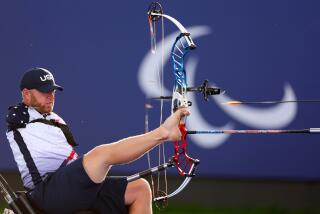Tel Aviv to Garden Grove, It’s Top Tennis
- Share via
Marilyn Hamilton raced to the baseline of the tennis court to reach a corner volley, slamming the ball back over the net and past her West German challenger.
Hamilton raised her racquet skyward, and a small crowd of fans cheered the athlete dressed in pink--from her racquet to her oversized earrings and T-shirt, right down to her wheelchair.
The 39-year-old Fresno woman, a top-seeded champion on the highly competitive wheelchair tennis circuit, was one of 250 disabled athletes from 10 countries who began play Friday in Irvine for the United States Open Wheelchair Tennis Championship.
It is the Wimbledon of wheelchair tennis, the most prestigious tournament in a growing international sport that offers players--many of them athletes before their injuries--a chance to compete, socialize and display skills that often leave able-bodied opponents gasping for breath. The players use special sports chairs that are lower, lighter and brighter than hospital-issue wheelchairs and they compete by standard rules, except that players are allowed two bounces before returning the ball.
“I had been a real active sports enthusiast all my life,” said Hamilton, who was injured in a hang-glider accident in 1979. “My question was, is there life after disability? I found tennis and skiing. The answer is yes.”
Brad Parks, a San Clemente player ranked No. 1 in the world, is credited with founding the sport after he broke his back in 1976 during a free-style skiing competition. He organized the National Foundation of Wheelchair Tennis in 1980, starting a network of tournaments that has expanded to 60 in the United States, with others in Europe, Australia, South America, Canada and Japan.
The U.S. Championship, sponsored by Everest & Jennings, a wheelchair manufacturer, has been staged at the Racquet
Club of Irvine since 1982. Ramps at the club’s entry, around bleachers and leading to the sunken center court are the only physical concessions needed by the disabled players. Though crowds were sparse on the opening day of international play Friday, hundreds are expected for the matches that culminate with finals between the best players on Oct. 16.
“We play tennis in terms of ability, not disability,” said John Sorenson, 35, a highly ranked player from Sydney, Australia. Sorenson, a former coal miner who was injured in a mine cave-in 1980, has traveled all over the world to play tennis. A competitive player in his youth, Sorenson returned to the game after seeing Parks play while he was hospitalized after the mine accident.
“Many of the best players were tennis players before injury,” he said. “Tennis is a difficult game to learn, and more difficult from a wheelchair.”
Play is fierce but fun. Sorenson said his goal is to “travel, meet people and have a good time--if I win, it’s a plus.”
The wheelchair players--accustomed to stares and physical barriers elsewhere--outnumbered the able-bodied racquet club members who paused to watch the early matches Friday. They rolled from court to court, stopping to exchange jokes and equipment tips with friends from Buenos Aires, Tel Aviv, Garden Grove and Corona del Mar.
Rick Cooper, the No. 7-ranked U.S men’s singles player, recalled beaning a British opponent in warm-up play. “He said, ‘My lawyer is going to see your lawyer,’ ” Cooper said. “I settled it out of court with a beer.”
Cooper, of Dallas, was a relief pitcher in the Oakland A’s farm system before he was paralyzed in a car accident in 1984. He wore a green and gold A’s cap Friday as he and doubles partner Chip Turner of Sacramento beat a Canadian team 6-1, 6-1.
Like Cooper and Marilyn Hamilton, who was U.S. national women’s wheelchair tennis champion in 1982 and 1983, many of the competitors are national or regional title-holders who train daily with coaches. But juniors and open tournament novices also play, and the degree of disability ranges from those who use wheelchairs but can get around on crutches to quadriplegics who use motorized wheelchairs and tape racquets to their arms.
“It’s the greatest tournament in the world,” said Regina Isecke, 35, of West Germany. “I play here because I want to play against the best.”
Nancy Olson, who ranks among the top three-ranked women in this country, said the competitive drive is universal among the players, regardless of the extent of their injury. Olson, 31, of Stony Point, N.Y., lost both legs when she was pinned between two cars six years ago.
“I always stay to watch the quadriplegic matches whenever I go to a tournament,” she said. “I might be a little physically better off than they are, but they still have the same competitive spirit as anyone else. It’s not what other people think--it’s what you put into it.”
More to Read
Go beyond the scoreboard
Get the latest on L.A.'s teams in the daily Sports Report newsletter.
You may occasionally receive promotional content from the Los Angeles Times.










